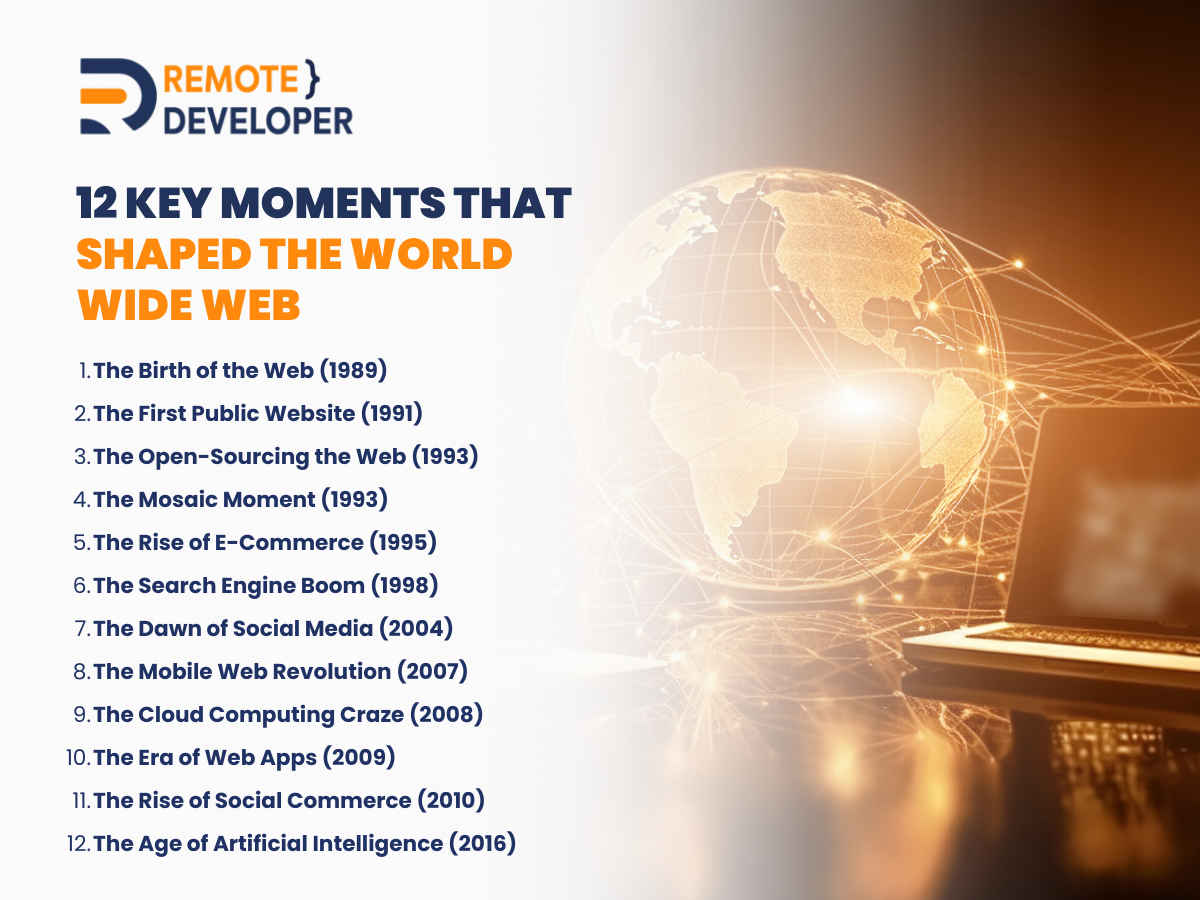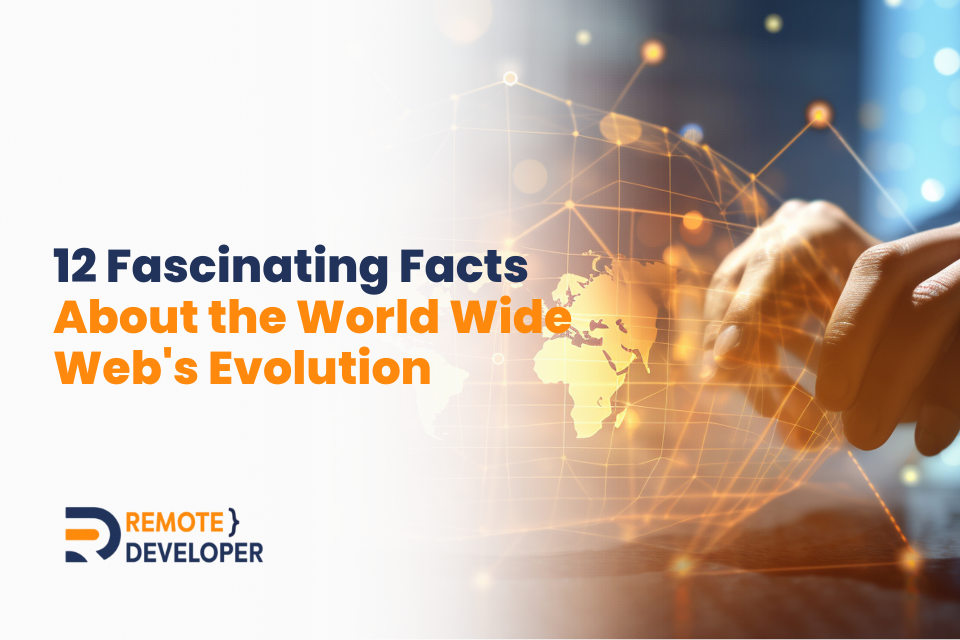The Web. An omnipresent force in our lives that connects billions of people across the globe and shapes the very fabric of information access. The birth and evolution are long, storied, and riddled with fascinating facts about the World Wide Web.
So, if you have asked at one point something along these lines: How did this technology emerge? What fascinating twists and turns have marked its evolution? Why is the Internet so important to the modern world?
Then, this article is for you.
Here, we are going beyond just a historical recounting. We are sharing the facts about the World Wide Web and valuable insights that detail the marvel of its exponential growth and technological leaps that propelled it to its current state today.
Without further ado, let us dive into this and uncover facts of our Internet history.
What Is the Significance of the World Wide Web in Modern Society?
There are only a few inventions that have shaped the modern world as profoundly as the World Wide Web.
Beyond its technical roots, the Internet has become intertwined in nearly every facet of our lives. It is not a stretch to even say that it is an integral cornerstone of the modern society we know and navigate today.
One of the undeniable facts about the World Wide Web is that it has revolutionised information access and dissemination.
Before its inception, knowledge was often siloed and difficult to obtain. Its presence has essentially sparked an online revolution that shattered these barriers and democratised information — granting millions of people unprecedented access to a vast and ever-expanding repository of knowledge.
Looking at how it is today, the Internet is an empowering tool that enables you to educate yourself on every imaginable topic, engage in discourse, and make informed decisions on a global scale.
It goes beyond just providing information access to people.
One of the key facts about the World Wide Web is that it has also woven itself into the fabric of commerce, which gave birth to a lot of things:
Consequently, it gave rise to e-commerce platforms and revolutionised how we shop and bank. Beyond this, it has streamlined financial transactions and enabled people to transcend the traditional workplace to work anywhere in the world with just a laptop.
These technological advancements have only boosted global economic activity and shaped modern society down to the fabric of our daily lives — offering us greater flexibility and convenience.
Early Days: A Glimpse Into the Birth of the World Wide Web
With that said, let us dive into the history of the World Wide Web, specifically the fascinating story of its inception:
The year is 1989. Tim Berners-Lee, a computer scientist at the European Council for Nuclear Research (CERN), was wrestling with the challenge of sharing information efficiently among researchers across the globe.
At this time, existing methods were clunky and were not user-friendly. Driven by this need, Berners-Lee proposed a revolutionary concept: A hypertext system for sharing information seamlessly over existing networks.
This proposal marked the advent of the World Wide Web.
The key to the Internet’s birth was the development of Hypertext Markup Language (HTML). This simple yet powerful language enabled the creation of interlinked documents which allowed users to effortlessly navigate information through hyperlinks.
From there, Berners-Lee further developed the first web browser, a rudimentary program capable of displaying and interacting with these HTML documents.
In 1991, the world witnessed the launch of the world’s first website. It was a simple web page that was largely different from the visually stunning pages that we associate with modern sites today.
Even so, that basic page laid the cornerstone for what we know and enjoy now.
The true turning point came in 1993. Berners-Lee made the critical decision to make the Web’s core technologies, including HTML and the web browser, available to the public for free.
This open-source approach attracted so many developers and users. As a result, his decision catapulted the Web to rapidly evolve and prompted a worldwide adoption of this technology.
As it gained momentum, its impact transcended its initial purpose for information sharing. Businesses saw its potential for marketing and communication, artists used it for creative expression, and individuals embraced it for communication and entertainment — a testament to its inherent flexibility and potential.

Milestones in Web Development: Key Moments That Shaped the Digital Landscape
Within the past three decades, there are a lot of things that happened — all thanks to web development. So, we condensed everything into 12 key facts about the World Wide Web
The Birth of the Web (1989)
Tim Berners-Lee, a visionary at CERN, conceptualised a system for hypertext document sharing.
The First Public Website (1991)
With the launch of the first public website at CERN, information dissemination transcended physical boundaries.
The Open-Sourcing the Web (1993)
Tim Berners-Lee decided to make HTML and the web browser available to everyone for free.
The Mosaic Moment (1993)
Marc Andreessen’s Mosaic browser transformed the Web from a text-based interface to a graphical one, complete with images and intuitive navigation.
The Rise of E-Commerce (1995)
The launch of Amazon and eBay marked the dawn of e-commerce, forever altering the retail landscape.
The Search Engine Boom (1998)
The innovative search algorithm platforms paved the way for efficient information retrieval and altered how we find information online.
The Dawn of Social Media (2004)
The launch of platforms like Facebook and MySpace ushered in the era of social media, connecting individuals and fostering online communities.
The Mobile Web Revolution (2007)
The release of the iPhone marked a paradigm shift towards mobile browsing, making the web accessible anytime, anywhere.
The Cloud Computing Craze (2008)
Cloud-based platforms like Amazon Web Services and Google Cloud Platform democratised access to computing resources. This enabled scalability, collaboration, and innovation for businesses and individuals.
The Era of Web Apps (2009)
Web applications like Gmail and Google Docs challenged the dominance of desktop software, offering browser-based alternatives that were accessible from any device.
The Rise of Social Commerce (2010)
Platforms like Etsy and Shopify allowed individuals to easily establish online businesses. This fostered a new era of e-commerce driven by social media integration and personalised shopping experiences.
The Age of Artificial Intelligence (2016)
AI has integrated into web development, powering features like chatbots, personalised recommendations, and intelligent search algorithms. This transformed user experiences and added another layer to how businesses interact with people.
The Impact of Technological Advancements on the Evolution of the Web
Understanding World Wide Web history is not just limited to knowing the events that led up to what it is today. It also extends to understanding the different innovations that were integrated to further its evolution.
Graphical User Interfaces (GUIs)
Early text-based websites were challenging to navigate. GUIs, with intuitive features like point-and-click navigation and multimedia elements, made the web user-friendly, sparking interest and widespread adoption.
Connectivity Expansion
Initially it was limited to academia. Soon after, the web’s reach exploded with personal computers thanks to Internet service providers (ISPs) and affordable dial-up access. This broader connectivity transformed the web from a niche tool to a mainstream phenomenon.
Search Engines
Search engines like AltaVista and Google emerged, offering efficient ways to find relevant information. It fundamentally changed how we access and consume information online.
Mobile Web Browsing
Smartphones and mobile Internet brought the Web into our pockets, making it accessible anytime, anywhere. This revolution increased user engagement and led to new applications and services tailored for mobile devices.
Social Media
Platforms like Facebook, Twitter, and Instagram have become integral parts of our online lives, fostering social connection, communication, and community building. This rise has redefined how we interact with information, news, and each other online.
Cloud Technology
Cloud computing transformed web development by providing on-demand access to computing resources, enabling scalability and flexibility for websites and applications. This shift made web development more efficient and accessible, leading to a wider range of innovative online services.
Web Applications
Online tools accessible via the Internet, like Gmail and Google Docs, offer functionality similar to traditional software applications but run entirely within a web browser. This shift made software more accessible and platform-independent.
Fun Facts About the World Wide Web: Pioneers and Innovators
Having a clear picture of its history and the innovations that propelled it to what it is today, let us take a moment to shift our focus and share a couple of facts about the World Wide Web — specifically the pioneers behind it.
Paul Baran
In the 1960s, Baran, while working at RAND Corporation, conceived the concept of packet switching, a fundamental principle of data transmission that is the cornerstone of modern networking. His work envisioned a decentralised and resilient communication system, crucial for the Internet’s ability to withstand disruptions.
Donald Davies
Working independently of Baran, Davies, a British computer scientist, also developed the concept of packet switching around the same time. He implemented it in the London National Physical Laboratory (NPL) network, demonstrating its practical feasibility.
Leonard Kleinrock
Known for his influential paper “On Distributed Communications,” Kleinrock explored theoretical aspects of packet switching and queueing theory, a study of the movement of information through a line. This provided a mathematical foundation for understanding network performance.
Tim Berners-Lee
This British computer scientist is widely recognised as the “father of the Web.” While working at CERN, the European Organisation for Nuclear Research, in 1989, Berners-Lee envisioned a system for sharing information seamlessly among researchers across the globe. His proposal laid the groundwork for the hypertext-based Web we know today.
Robert Cailliau
Alongside Berners-Lee, Belgian engineer Cailliau also played a crucial role in shaping the Web’s technical foundation. He actively participated in developing the early browser and server software, ensuring the Web’s practical implementation. Cailliau was also the one who suggested the now-ubiquitous term “World Wide Web,” highlighting its global reach and interconnected nature.
Marc Andreessen and Eric Bina
The Mosaic browser, developed by the duo at the National Center for Supercomputing Applications (NCSA) in 1993, marked a pivotal moment. Its user-friendly graphical interface and intuitive navigation ignited widespread public interest in the Web, propelling it beyond the realm of academia.
Vint Cerf and Robert Kahn
Often referred to as the “fathers of the Internet” for their pivotal contributions, Cerf and Kahn laid the groundwork with the Transmission Control Protocol/Internet Protocol (TCP/IP) suite. This communication protocol, developed in the 1970s, enabled different networks to connect seamlessly, forming the foundation for the Internet that would underpin the Web.
Turning Points: Events That Revolutionised Online Communication and Connectivity
Of course, just knowing what happened and the people behind the birth of the Web is just a portion of its storied past.
So, we are also sharing the facts about the World Wide Web that irrevocably changed how we, as a collective, communicate and connect online — yes, we are looking at the very communication tools we use daily:
Before the Web, sending even a short message across long distances required a lot of time for physical letters to arrive from Point A to Point B. While the first email platforms that were available to the public were launched back in the 1990s, the very first email stretches back further.
It begins with Ray Tomlinson. In 1971, he was working on the Advanced Research Projects Agency Network (ARPANET), a precursor to the modern Internet. At that time, Tomlinson successfully sent the first email between two machines on the network. This seemingly simple act laid the foundation for the first-ever email to be sent.
Instant Messaging
In the mid-1990s, a paradigm shift arrived in the form of instant messaging (IM), forever altering how people connect and express themselves online.
Launched in 1996, ICQ, initially marketed as “I Seek You,” brought the concept of real-time text-based chat to the masses. Gone were the days of waiting for email replies or coordinating phone calls. With the advent of IM, people could now send and receive messages instantaneously, fostering a sense of immediacy and presence never before experienced online.
Social Media
The Web was made up of online interactions that resembled a scattered archipelago of isolated forums and chat rooms. Every communication was often topic-specific and lacked the unifying element that would later mould today’s digital landscape.
Then when social media came onto the scene, it transformed how people connect and express themselves online.
SixDegrees one of the precursors of social media was launched in 1997. It laid the groundwork by connecting users based on shared acquaintances. But, it was only in the early 2000s when platforms like Friendster and MySpace marked the birth of the social networking phenomenon we know today.
The Role of User-Generated Content in Shaping the Web
If you think about it: The reality of the early Internet, the World Wide Web would just be a static library, filled with pre-packaged information accessed if there were no people to generate content.
That is why user-generated content (UGC) is a phenomenon that fundamentally transformed the Web from a one-way street to a vibrant, dynamic ecosystem where people can express themselves through their content.
It is important to acknowledge the early seeds of UGC. These paved the way for a more participatory Internet:
- Online Forums
- Bulletin Board Systems
- Personal Blogs
However, the true explosion of UGC began in the early 2000s with platforms like YouTube, Flickr, and Wikipedia. These empowered individuals to share videos, photos, and information, and gave rise to a wave of creative expression and knowledge exchange.
Here is how UCG reshaped the World Wide Web:
- Empowered anyone with an Internet connection to become a creator, contributing diverse perspectives and enriching the web’s content landscape.
- Traditional gatekeepers of information no longer hold exclusive control. User reviews, social media trends, and viral content can influence public opinion and challenge established narratives, empowering audiences and fostering a more diverse information ecosystem.
- Creators can now monetise their work through platforms like YouTube and Patreon. This fostered new creative economies and empowered individuals to turn their passions into livelihoods.
- Businesses leverage UGC for authentic customer testimonials, engaging social media campaigns, and influencer marketing, fostering trust and building stronger brand relationships.
- Citizens are encouraged to share breaking news and firsthand accounts on social media platforms, complementing traditional journalism and providing diverse perspectives on events.
Mobile Revolution: How Smartphones Changed the Way We Access the Internet
The way we navigate the Web today is completely different from how it used to be. Before, people lacked the mobility and immediacy that is starkly different from our current online experience.
Not surprisingly, the advent of smartphones and mobile web browsing forever altered how we engage with the Internet and shaped the very fabric of our interconnected world.
While there were already phones before, the year the Apple iPhone debuted marked a pivotal moment. The iconic sleek device, boasting a touchscreen interface and Internet connectivity, ignited a wave of innovation in the mobile industry. Not long after, Android-powered devices and other competitors joined the fray, each competing for a place in the pockets and hearts of users.
Enabled to surf the Web, smartphones became gateways to a universe of information and digital experiences provided by the Web. This seamless accessibility gave rise to a couple of things:
- It facilitated constant connection, empowering users to access information, communicate, and transact regardless of location.
- It brought online access to previously underserved populations, bridging the digital divide and fostering global inclusion.
- It became a platform for countless applications, revolutionising how we perform everyday tasks, consume content, and engage with the world around us.
- It fueled the rapid growth of social media platforms, enabling constant interaction, content sharing, and community building on the go.
The Future of the World Wide Web: Predictions and Emerging Trends
With all that said, the World Wide Web is a portal for information sharing and a means to foster connections. But it is also an ever-evolving entity that has vastly grown from its humble roots into what it is today in just a few short decades.
It is no stretch of the imagination that future innovations will give rise to upcoming web trends that will reshape the Web and how we, as a collective, consume information and connect.
You could even say that the future is already here. Some organisations and individuals are also paving the way and showing us what the next few years will look like. While the speed of adoption of these trends may vary, some of these will inevitably become an integral element:
- The Web 3.0 vision, with its emphasis on decentralisation and user ownership, might pave the way for immersive experiences fueled by technologies like Augmented Reality (AR) and Virtual Reality (VR).
- Web development powered by AI could offer personalised, dynamic experiences that adapt to individual preferences and learning styles.
- Moving beyond simple keyword searches, the semantic web aims to connect information meaningfully, allowing machines to grasp the nuances of human language and context. This could revolutionise online research and knowledge discovery.
- Lastly, everyday objects will communicate more seamlessly, creating a symphony of automation and convenience. The proliferation of smart devices and the Internet of Things (IoT) promises a Web that is intimately interwoven into the very fabric of our daily lives.
Ready to dive into the history of the World Wide Web? Explore our guide for fascinating facts that shaped the digital revolution. Join us on this journey through time! Discover more on our blog now.

